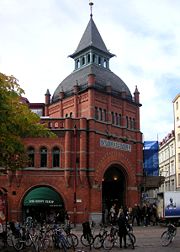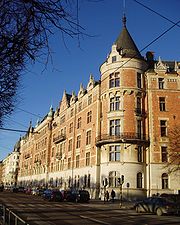
Isak Gustaf Clason
Encyclopedia


Sweden
Sweden , officially the Kingdom of Sweden , is a Nordic country on the Scandinavian Peninsula in Northern Europe. Sweden borders with Norway and Finland and is connected to Denmark by a bridge-tunnel across the Öresund....
architect
Architect
An architect is a person trained in the planning, design and oversight of the construction of buildings. To practice architecture means to offer or render services in connection with the design and construction of a building, or group of buildings and the space within the site surrounding the...
.
Biography
Clason studied engineeringEngineering
Engineering is the discipline, art, skill and profession of acquiring and applying scientific, mathematical, economic, social, and practical knowledge, in order to design and build structures, machines, devices, systems, materials and processes that safely realize improvements to the lives of...
and later architecture
Architecture
Architecture is both the process and product of planning, designing and construction. Architectural works, in the material form of buildings, are often perceived as cultural and political symbols and as works of art...
at the Institute of Technology
Royal Institute of Technology
The Royal Institute of Technology is a university in Stockholm, Sweden. KTH was founded in 1827 as Sweden's first polytechnic and is one of Scandinavia's largest institutions of higher education in technology. KTH accounts for one-third of Sweden’s technical research and engineering education...
in Stockholm
Stockholm
Stockholm is the capital and the largest city of Sweden and constitutes the most populated urban area in Scandinavia. Stockholm is the most populous city in Sweden, with a population of 851,155 in the municipality , 1.37 million in the urban area , and around 2.1 million in the metropolitan area...
, where he was a student of A. T. Gellerstedt, and later at the architectural school of the Academy of Arts
Royal Swedish Academy of Arts
The Royal Swedish Academy of Arts or Kungl. Akademien för de fria konsterna, founded in 1773 by King Gustav III, is one of the Royal Academies in Sweden...
, at the time headed by Fredrik Wilhelm Scholander. He received the royal medal in 1881 and studied abroad 1883-1886. He was elected member of the Academy of Arts in 1889, appointed professor of architecture at the Royal Institute of Technology
Royal Institute of Technology
The Royal Institute of Technology is a university in Stockholm, Sweden. KTH was founded in 1827 as Sweden's first polytechnic and is one of Scandinavia's largest institutions of higher education in technology. KTH accounts for one-third of Sweden’s technical research and engineering education...
in 1889 and became first surveyor in the Chief Surveyor's Office in 1904. He became vice president of the Art Academy in 1902 and president in 1918. He was also elected member of the Royal Academy of Sciences in 1907.
Work
His first major work was the Bünsow building (1886-1888) at StrandvägenStrandvägen
Strandvägen is a boulevard on Östermalm in central Stockholm, Sweden. Completed just in time for the Stockholm World's Fair 1897, it quickly became known as one of the most prestigious addresses in town....
in Stockholm, commissioned by the sawmill baron Friedrich Bünsow and influenced by French renaissance architecture
French Renaissance architecture
French Renaissance architecture is the style of architecture which was imported to France from Italy during the early 16th century and developed in the light of local architectural traditions....
. It broke new ground in its use of natural material throughout (limestone
Limestone
Limestone is a sedimentary rock composed largely of the minerals calcite and aragonite, which are different crystal forms of calcium carbonate . Many limestones are composed from skeletal fragments of marine organisms such as coral or foraminifera....
and brick
Brick
A brick is a block of ceramic material used in masonry construction, usually laid using various kinds of mortar. It has been regarded as one of the longest lasting and strongest building materials used throughout history.-History:...
s) rather than the plaster
Plaster
Plaster is a building material used for coating walls and ceilings. Plaster starts as a dry powder similar to mortar or cement and like those materials it is mixed with water to form a paste which liberates heat and then hardens. Unlike mortar and cement, plaster remains quite soft after setting,...
that had been dominant in Swedish architecture
Architecture of Sweden
This article covers the architecture of Sweden from a historical perspective. As is the norm in architecture history, an architectural history of a nation naturally lends itself to a history of those monuments to the development of that nation and its institutions of power; palaces, castles, and...
until that point. It also broke against conventions through its avoidance of complete symmetry. He also built Östermalmshallen (1889) in Stockholm (the indoor market at Östermalmstorg
Östermalmstorg
Östermalmstorg is a square in the district of Östermalm, Stockholm. It is known for its food market hall, Östermalmshallen, opened in 1889. Östermalmstorg was also the location of the first Åhléns City department store, opened in 1932....
and, together with Kasper Sahlin), the house at 14, Österlånggatan
Österlånggatan
Österlånggatan is a street in Gamla stan, the old town of Stockholm, Sweden. Stretching southward from Slottsbacken to Järntorget, it forms a parallel street to Baggensgatan and Skeppsbron...
(1888-1889), and the Adelsvärd House at Norrström in Stockholm (1889).
His largest commission was the Nordic Museum
Nordic Museum
The Nordic Museum is a museum located on Djurgården, an island in central Stockholm, Sweden, dedicated to the cultural history and ethnography of Sweden from the Early Modern age until the contemporary period...
on Djurgården, in North European Renaissance
Northern Renaissance
The Northern Renaissance is the term used to describe the Renaissance in northern Europe, or more broadly in Europe outside Italy. Before 1450 Italian Renaissance humanism had little influence outside Italy. From the late 15th century the ideas spread around Europe...
style, which he began in collaboration with M. Isaeus but continued alone after Isaeus's death in 1890. The building was partly finished for the Stockholm Exhibition
General Art and Industrial Exposition of Stockholm (1897)
The General Art and Industrial Exposition of Stockholm of 1897 also known as Stockholm Exhibition or Stockholm World's Fair was a World's Fair staged in 1897 in Stockholm, Sweden....
in 1897, and completed a few years later.
Other designs include the Hallwyl Palace
Hallwyl Palace
The Hallwyl Palace is a historical building in central Stockholm located on 4, Hamngatan facing Berzelii Park.The palace was built 1893-1898 to the design of Isak Gustaf Clason for Count Walther von Hallwyl and his wife Wilhelmina. It was created to accommodate the office of the count and the...
, also in Stockholm, the Rosen house at Strandvägen, and the building for Ständernas allmänna brandförsäkring, an insurance company, at Skeppsbron
Skeppsbron
Skeppsbron is both a street and a quay in Gamla stan, the old town of Stockholm, capital of Sweden, stretching from the bridge Strömbron in front of the Royal Palace southward to Slussen....
in the Old Town
Gamla stan
Gamla stan , until 1980 officially Staden mellan broarna , is the old town of Stockholm, Sweden. Gamla stan consists primarily of the island Stadsholmen. The surrounding islets Riddarholmen, Helgeandsholmen, and Strömsborg are officially part of, but not colloquially included in, Gamla stan...
of Stockholm. Clason also is responsible for the façade of Norrlands nation
Norrlands nation
Norrlands nation is a student society and the largest of thirteen nations at Uppsala University. It mainly recruits its members from the province of Norrland, which is the northern-most part of Sweden...
in Uppsala
Uppsala
- Economy :Today Uppsala is well established in medical research and recognized for its leading position in biotechnology.*Abbott Medical Optics *GE Healthcare*Pfizer *Phadia, an offshoot of Pharmacia*Fresenius*Q-Med...
.

